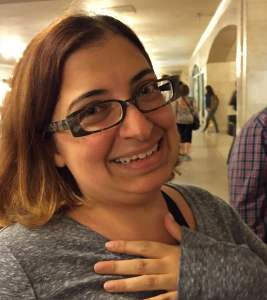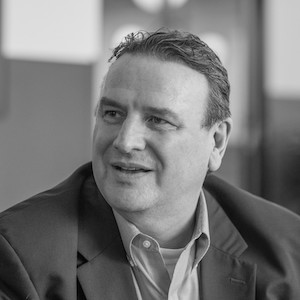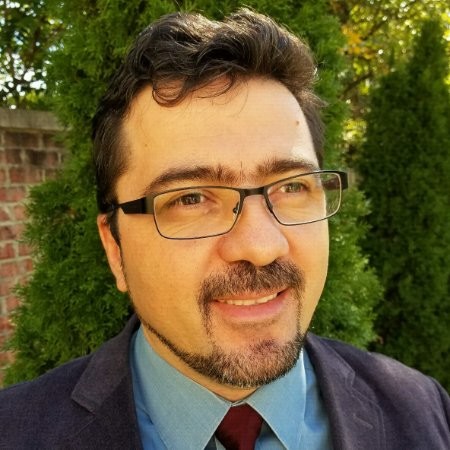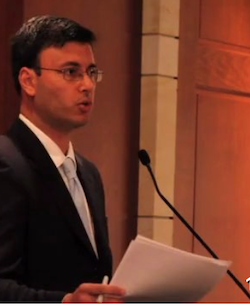Feature Articles
How to Care for the Community Over the Code
 At All Things Open 2016, Joe Brockmeier answers the question: How can companies can work effectively with open source communities? In his talk, Joe reminded us of the #1 open source myth: Open source is comprised of mostly volunteers. The truth is, these days, pretty much any major open source project has people who are paid to work on it. There are always people who do it because they love it, but these days most of us are paid (and still love it). Over the years we have learned that if you want patches in a timely manner, you need people who are paid to do it...
At All Things Open 2016, Joe Brockmeier answers the question: How can companies can work effectively with open source communities? In his talk, Joe reminded us of the #1 open source myth: Open source is comprised of mostly volunteers. The truth is, these days, pretty much any major open source project has people who are paid to work on it. There are always people who do it because they love it, but these days most of us are paid (and still love it). Over the years we have learned that if you want patches in a timely manner, you need people who are paid to do it...
Data Exchange Vendor Metriport Adopts Open Source
 Metriport is addressing a problem similar to other IT companies in health care—a service to ingest and clean patient data for tasks such as providing care summaries during a patient transition—but is doing so in a very unusual way: through an entirely open source service. Because the choice to go open source is so central to their business model, I will discuss the importance of free and open source software in health care, then explain Metriport's service.
Metriport is addressing a problem similar to other IT companies in health care—a service to ingest and clean patient data for tasks such as providing care summaries during a patient transition—but is doing so in a very unusual way: through an entirely open source service. Because the choice to go open source is so central to their business model, I will discuss the importance of free and open source software in health care, then explain Metriport's service.
Who Controls Your Smartphone? And How to Leverage Open Source to Prevent it from Spying on You
 There are many things about today’s world that warrant us asking that question. Do you or the mobile vendor control your smartphones? If you are a consumer, small or medium business (SMB) -- the answer is the vendor...What if you are a large enterprise or a government agency? The answer is still the vendor...How can the user regain control? Not all vendors have locked devices and walled gardens. Google’s line of Pixel hardware, for example, is a mid-market solution whose bootloader allows locking and re-locking. Pixels support two versions of Android. Google Mobile Services (GMS), where free services are tied to data monetization and a UX like Apple and Samsung devices. Secondly, Pixels can run Android Open-Source Project (AOSP) code that shares the same strengths as the GMS build, but the customer controls the code base and updates. There are several companies that are selling AOSP operating system builds for Pixel and other unlockable/lockable mobile phones and tablets...
There are many things about today’s world that warrant us asking that question. Do you or the mobile vendor control your smartphones? If you are a consumer, small or medium business (SMB) -- the answer is the vendor...What if you are a large enterprise or a government agency? The answer is still the vendor...How can the user regain control? Not all vendors have locked devices and walled gardens. Google’s line of Pixel hardware, for example, is a mid-market solution whose bootloader allows locking and re-locking. Pixels support two versions of Android. Google Mobile Services (GMS), where free services are tied to data monetization and a UX like Apple and Samsung devices. Secondly, Pixels can run Android Open-Source Project (AOSP) code that shares the same strengths as the GMS build, but the customer controls the code base and updates. There are several companies that are selling AOSP operating system builds for Pixel and other unlockable/lockable mobile phones and tablets...
Radiology Initiatives Illustrate Uses for Open Data and Open AI research
 Fans of data in health care often speculate about what clinicians and researchers could achieve by reducing friction in data sharing. What if we had easy access to group repositories, expert annotations and labels, robust and consistent metadata, and standards without inconsistencies? Since 2017, the Radiological Society of North America (RSNA) has been displaying a model for such data sharing. That year marked RSNA's first AI challenge. RSNA has worked since then to make the AI challenge an increasingly international collaboration. Organizers of each challenge curate and annotate medical imaging studies and ask the research community to come up with models to answer important questions.
Fans of data in health care often speculate about what clinicians and researchers could achieve by reducing friction in data sharing. What if we had easy access to group repositories, expert annotations and labels, robust and consistent metadata, and standards without inconsistencies? Since 2017, the Radiological Society of North America (RSNA) has been displaying a model for such data sharing. That year marked RSNA's first AI challenge. RSNA has worked since then to make the AI challenge an increasingly international collaboration. Organizers of each challenge curate and annotate medical imaging studies and ask the research community to come up with models to answer important questions.
The Appeal of Graph Databases for Health Care
 A lot of valuable data can be represented as graphs. Genealogical charts are a familiar example: they represent people as boxes, connected by lines that represent parent/child or marriage relationships. In mathematics and computer science, graphs have become a discipline all their own. Now their value for health care is emerging. Graph computing made a significant advance this past February in the form of a Graph Data Science (GDS) library for the free and open source Neo4j graph database. Graph databases are proving their value in clinical research and public health; I wonder whether they can also boost analytics for providers. This article explains what's special about graph databases, and some applications in health care highlighted by recent webinars offered by the Neo4j company.
A lot of valuable data can be represented as graphs. Genealogical charts are a familiar example: they represent people as boxes, connected by lines that represent parent/child or marriage relationships. In mathematics and computer science, graphs have become a discipline all their own. Now their value for health care is emerging. Graph computing made a significant advance this past February in the form of a Graph Data Science (GDS) library for the free and open source Neo4j graph database. Graph databases are proving their value in clinical research and public health; I wonder whether they can also boost analytics for providers. This article explains what's special about graph databases, and some applications in health care highlighted by recent webinars offered by the Neo4j company.
Affordable COVID-19 Diagnoses for Hospitals: How Open Source Software Helps
 The most common COVID-19 symptoms—such as coughing, fever, and shortness of breath—are shared with many other diseases. Diagnosing a patient accurately is therefore a challenge. Although a diagnosis of COVID-19 might not affect treatment, it would help a hospital predict a patient's trajectory and anticipate the need for urgent intervention. But current tests, relying on blood or mucus samples, are not particularly accurate. In this article, we'll see how open source software can help hospitals make better diagnoses. I'll concentrate on one specific role, and on the ways open source facilitates finding a solution and keeping it affordable. Many aspects of the problem feed into the solution discussed here. The article is based on work by researcher Trevor Grant.
The most common COVID-19 symptoms—such as coughing, fever, and shortness of breath—are shared with many other diseases. Diagnosing a patient accurately is therefore a challenge. Although a diagnosis of COVID-19 might not affect treatment, it would help a hospital predict a patient's trajectory and anticipate the need for urgent intervention. But current tests, relying on blood or mucus samples, are not particularly accurate. In this article, we'll see how open source software can help hospitals make better diagnoses. I'll concentrate on one specific role, and on the ways open source facilitates finding a solution and keeping it affordable. Many aspects of the problem feed into the solution discussed here. The article is based on work by researcher Trevor Grant.
Artificial intelligence in medicine: Is the genie out of the bottle?
 It is probably a given that artificial intelligence (AI) will become an integral part of healthcare delivery and of our public health infrastructure. What is not a given is that we will easily reach that point, and maintain progress in a way that maximizes its effectiveness in achieving the goals we have come to expect of it – efficient and improved healthcare and public health systems. In other words, making the health of people better in a cost-effective way. Responsible commentators have already begun to question the value of AI in medicine.
It is probably a given that artificial intelligence (AI) will become an integral part of healthcare delivery and of our public health infrastructure. What is not a given is that we will easily reach that point, and maintain progress in a way that maximizes its effectiveness in achieving the goals we have come to expect of it – efficient and improved healthcare and public health systems. In other words, making the health of people better in a cost-effective way. Responsible commentators have already begun to question the value of AI in medicine.
Using Digital Ledger Technology To Put Physicians Back In Control
 Our healthcare system is failing. It costs more and has overall worse outcomes than any other industrialized nation. It is failing because those on the front lines of healthcare - the physicians and patients- have no say in how the system is run. Distributed Ledger Technology (DLT) - otherwise known as blockchain - has the ability to change that. DLT allows for secure direct peer to peer (In healthcare this means patient to doctor and doctor to doctor) communication and data transfer. No more storage of private information and transactions on centralized data capturing systems like electronic health records platforms.
Our healthcare system is failing. It costs more and has overall worse outcomes than any other industrialized nation. It is failing because those on the front lines of healthcare - the physicians and patients- have no say in how the system is run. Distributed Ledger Technology (DLT) - otherwise known as blockchain - has the ability to change that. DLT allows for secure direct peer to peer (In healthcare this means patient to doctor and doctor to doctor) communication and data transfer. No more storage of private information and transactions on centralized data capturing systems like electronic health records platforms.
How Laboratories and their Systems can Weather Natural Disasters and Pandemics
 We are currently experiencing a global pandemic - which, while perhaps included in disaster preparedness Standard Operating Procedures (SOPs) by many labs as a possible disaster, still has caught most the infrastructure and health systems of most nations largely unprepared, and is causing major disruption because it was arguably not seen as one of the most likely events. Disaster preparedness has typically tended to focus on IT and data management risks and/or natural disasters. SOPs center around standard, daily lab safety. The truth is that whatever the odds of a particular disaster, they become 100% once they happen. It's important to have sufficient risk-reduction SOPs in play, and a good Continuity Of Operations Plan (COOP) for each potential scenario to ensure the best chance of coping during the event and recovering afterwards.
We are currently experiencing a global pandemic - which, while perhaps included in disaster preparedness Standard Operating Procedures (SOPs) by many labs as a possible disaster, still has caught most the infrastructure and health systems of most nations largely unprepared, and is causing major disruption because it was arguably not seen as one of the most likely events. Disaster preparedness has typically tended to focus on IT and data management risks and/or natural disasters. SOPs center around standard, daily lab safety. The truth is that whatever the odds of a particular disaster, they become 100% once they happen. It's important to have sufficient risk-reduction SOPs in play, and a good Continuity Of Operations Plan (COOP) for each potential scenario to ensure the best chance of coping during the event and recovering afterwards.
DoD Looks for Disaster Response Solutions Through Artificial Intelligence Innovation Competition
 An important new trend in the federal sector involves the use of "innovation competitions" to develop Artificial Intelligence (AI) solutions for major problems that the agencies face. An ongoing AI innovation competition from Centers for Medicare and Medicaid Services (CMS), known as the Artificial Intelligence (AI) Health Outcomes Challenge began in March 2019. While that competition is only open to major consulting firms, the Department of Defense (DoD) was the trendsetter here and has been working on a series of AI competitions that began with the xView competition in March 2018.
An important new trend in the federal sector involves the use of "innovation competitions" to develop Artificial Intelligence (AI) solutions for major problems that the agencies face. An ongoing AI innovation competition from Centers for Medicare and Medicaid Services (CMS), known as the Artificial Intelligence (AI) Health Outcomes Challenge began in March 2019. While that competition is only open to major consulting firms, the Department of Defense (DoD) was the trendsetter here and has been working on a series of AI competitions that began with the xView competition in March 2018.
Open Source Governance and the Rise of a New Open Health Movement
 It's hard to tell if (or when) new open source foundations will appear and claim a leading role in healthcare. It would be interesting to see one created to scale an existing viable model, such as the one from Oroville Hospital using VistA. Or we could see OSEHRA shifting its focus and expanding its charter beyond just the US government space. Nevertheless, the successful foundation would keep a low barrier to entry for innovators, allowing them to incorporate and scale open source healthcare technologies into commercial products. Time will tell, but what's for certain is that we live in interesting times, and I am looking forward to massive innovation in healthcare in the near future. The time is ripe.
It's hard to tell if (or when) new open source foundations will appear and claim a leading role in healthcare. It would be interesting to see one created to scale an existing viable model, such as the one from Oroville Hospital using VistA. Or we could see OSEHRA shifting its focus and expanding its charter beyond just the US government space. Nevertheless, the successful foundation would keep a low barrier to entry for innovators, allowing them to incorporate and scale open source healthcare technologies into commercial products. Time will tell, but what's for certain is that we live in interesting times, and I am looking forward to massive innovation in healthcare in the near future. The time is ripe.
Using Open Technology To Build a Biodefense Against the Coronavirus
 As the number of US cases of the coronavirus rises, how will healthcare professionals be able to tell the difference between which panicked patients with similar symptoms has what? Even if the patient hasn't traveled to Wuhan or China recently, what if they sat at a Starbucks with someone who did? With the incubation time-lag before symptoms appear, who would even know? The challenge of monitoring 330 million people for infectious disease outbreaks is daunting. Take the flu as an example. During the last flu season which, as already discussed, was not as complex as this year's season, approximately 35.5 million Americans had flu symptoms, 16.5 million received medical care, 490,600 were hospitalized and 34,200 died.
As the number of US cases of the coronavirus rises, how will healthcare professionals be able to tell the difference between which panicked patients with similar symptoms has what? Even if the patient hasn't traveled to Wuhan or China recently, what if they sat at a Starbucks with someone who did? With the incubation time-lag before symptoms appear, who would even know? The challenge of monitoring 330 million people for infectious disease outbreaks is daunting. Take the flu as an example. During the last flu season which, as already discussed, was not as complex as this year's season, approximately 35.5 million Americans had flu symptoms, 16.5 million received medical care, 490,600 were hospitalized and 34,200 died.
Sure Strategies for Improving Health and Education: 2020 and Beyond
 Our paths cross as we enter a new decade and consider the next ten years can lead to marked improvements in healthcare delivery - something sorely needed but doable. To that end, we've identified three key developments that can and should be implemented. These are not the only needed improvements and avenues to be pursued; that would take a book or a longer article. So, we've focused on what are, for us, three of the most innovative possibilities. One added word: some of the three innovations or aspects of them may strike readers as fanciful or imaginary or over-the-proverbial-top. But, the speed with which technology is changing, the pressing need for solutions and our capacities to consider new paradigms for solving old problems are converging.
Our paths cross as we enter a new decade and consider the next ten years can lead to marked improvements in healthcare delivery - something sorely needed but doable. To that end, we've identified three key developments that can and should be implemented. These are not the only needed improvements and avenues to be pursued; that would take a book or a longer article. So, we've focused on what are, for us, three of the most innovative possibilities. One added word: some of the three innovations or aspects of them may strike readers as fanciful or imaginary or over-the-proverbial-top. But, the speed with which technology is changing, the pressing need for solutions and our capacities to consider new paradigms for solving old problems are converging.
How DoD Plans to Leverage Artificial Intelligence and Open Source to Improve Emergency Response and Disaster Relief
 Some might not know it, but the US military plays a key role in US disaster response strategy and, accordingly, the Department of Defense (DoD) has prioritized its disaster response mission and is investing heavily towards increasing its capabilities and effectiveness. Technology is a big part of all modern DoD missions, and disaster response is no different. The most promising and transformative technology on the horizon for our future, and for the future of the DoD, is Artificial Intelligence (AI). So how exactly will the DoD leverage Artificial Intelligence technologies in order to meet the demands of the disaster response mission? Is a new Center of Excellence created by DoD, called the Joint Artificial Intelligence Center (JAIC). Read More »
Some might not know it, but the US military plays a key role in US disaster response strategy and, accordingly, the Department of Defense (DoD) has prioritized its disaster response mission and is investing heavily towards increasing its capabilities and effectiveness. Technology is a big part of all modern DoD missions, and disaster response is no different. The most promising and transformative technology on the horizon for our future, and for the future of the DoD, is Artificial Intelligence (AI). So how exactly will the DoD leverage Artificial Intelligence technologies in order to meet the demands of the disaster response mission? Is a new Center of Excellence created by DoD, called the Joint Artificial Intelligence Center (JAIC). Read More »
Major Interoperability Initiative Launched During the Annual Meeting of The Sequoia Project
 On December 5, 2019, HLN Consulting, LLC participated in The Sequoia Project's day long annual meeting which was held just outside of Washington, D.C. at the Gaylord National Resort & Convention Center. As a leading healthcare informatics consulting company HLN monitors developments in healthcare interoperability nationally with particular emphasis on the impact to public health agencies and their stakeholders. This conference represented a good opportunity to participate in the start of a major interoperability initiative that will play out over the next several years. In addition to this report, the Sequoia Project posted the proceedings of the meeting online, including the recorded discussions as well as the slides from the presentations. Read More »
On December 5, 2019, HLN Consulting, LLC participated in The Sequoia Project's day long annual meeting which was held just outside of Washington, D.C. at the Gaylord National Resort & Convention Center. As a leading healthcare informatics consulting company HLN monitors developments in healthcare interoperability nationally with particular emphasis on the impact to public health agencies and their stakeholders. This conference represented a good opportunity to participate in the start of a major interoperability initiative that will play out over the next several years. In addition to this report, the Sequoia Project posted the proceedings of the meeting online, including the recorded discussions as well as the slides from the presentations. Read More »